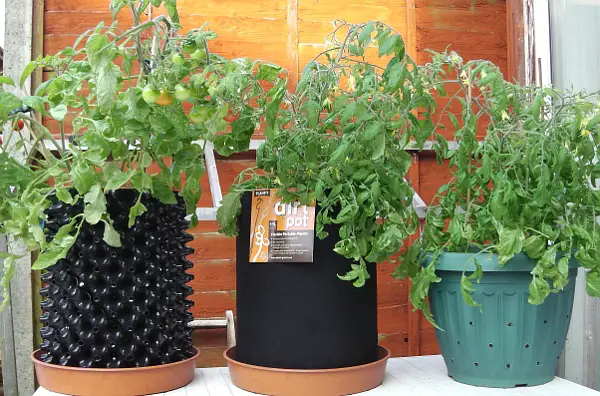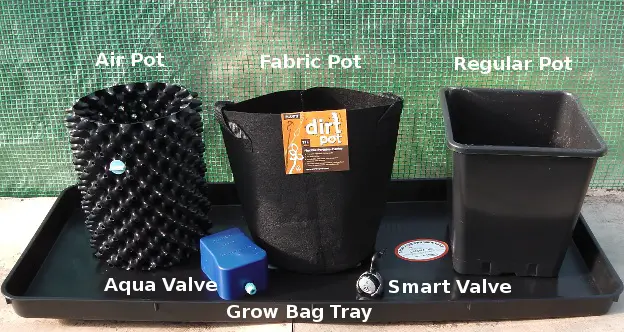Today I explain what I consider to be the best growing system available for the hobby grower.
It’s based on the auto pot system with one or two references to the quadgrow planter but in my opinion, the system shown below is as good or better and less expensive!
The Ultimate Growing System
We know how important it is to provide oxygen to the root zone by mixing perlite with regular compost.
Growing Tomatoes In Air Pots and Fabric Pots
Also, using pots that have air access through the pot sides such as the air pot and fabric pot. This improves the rate of growth and root health.
We can also improve a standard pot by drilling holes in the sides as in the photo below. However, aeration is only half the secret.

Water & Nutrient Delivery
The next step is to provide water and nutrients whenever a plant needs them but without keeping the pot standing inches deep in a tray of water and the growing medium saturated – that would undo the good work of the perlite and aeration.
The Wet / Dry Cycle
There are two devices on the market that allow automatic watering (and feeding) in a wet/dry cycle. The wet/dry cycle allows air back into the medium, before the pot is watered again.
What happens is this…
- A given level of water (containing nutrients) is allowed into a tray.
- The plants absorb all of the water before the tray is refilled.
As the water is used, so air is allowed back into the growing medium as the water level drops and roots remain healthy.
These are most of the tools for the job in the photo below.

- An aqua valve or smart valve can be used – one per tray.
- Three air pots or fabric pots are placed inside a grow bag tray.
- What isn’t in the pic is the container of water with nutrients that is attached to the valve.
In my opinion, this system is the most effective way to grow tomatoes. It may not be as simple as the quadgrow or as refined as the auto pot system but it has all the growing benefits and is less expensive!
The items above may be bought from the following links:
The grow bag tray can be bought at any garden centre.
If you are interested in buying the dirt pots, aqua or smart valves, I can get them at a lower price for the members of the newsletter – please email me for more details. [email protected]
More about this system in the coming weeks!
Translocation & Diagnosing Nutrient Deficiency
If we were fortune tellers we could probably read the tea leaves.
However, we are tomato growers and we can read the tomato leaves … to a degree!
How do we do it?
In part, by understanding “Translocation” – that sound complicated!
The upper leaves (the growing tip) take nutrients from the lower leaves. This happens if a plant isn’t getting enough of a particular nutrient through the roots.
For example, when lower leaves turn pale green/yellow, it is often because more nitrogen, is required by the top leaves – so the nitrogen is moved from the bottom leaves to the top of the plant.
However, sometimes it’s the top growth that has pale leaves but the bottom leaves remain a nice green colour … this is probably iron deficiency.
How do we know this?
The thing is … not all nutrients can be moved around a plant at the same speed – or at all!
Some minerals are fast movers (nitrogen and magnesium for example), some minerals are a lot slower (such as Iron and calcium – calcium is a real slow coach – that’s why we often see blossom end rot).
So when a plant’s leaves are turning pale, we need to know whether it’s the top or bottom leaves in order to discover which nutrient is deficient.
A deficiency in …
- A fast moving nutrient will make the lower leaves deficient – show pale in colour.
- A slow moving nutrient will make the upper leaves deficient – show pale in colour.
When a plant can’t access enough of a nutrient through its roots.
This mostly happens when soil temperatures are cool in spring, when soil is over/under watered or plants are growing at a rapid speed and need more nutrients.
Nutrients, Oxygen and Root Capping
One issue that is very common in container grown plants is Iron deficiency. Shows as pale leaves at the top of a growing tip – new growth.
Iron is absorbed into the roots with the aid of oxygen. So, iron deficiency can be caused by a lack of oxygen in the root zone.
This is very common in container grown plants because it is easy to over-water them, removing the oxygen. Also, the surface area of a pot is much less than that of a plant grown in the ground or a grow bag. Air is absorbed mostly by surface roots so the less surface area there is, the less oxygen the roots have access to.
This is further exacerbated by surface roots becoming pot bound and forming a tightly-knit “root cap” which prevents air from entering the soil surface.
Later in the season I’ll show ways to prevent “root capping” and when it does occur, show a way to get air in to roots.
Of course these are good reasons to use pots that allow air into the roots through the sides!
If you have any comments I’d love to hear from you!
Regards,
Nick
